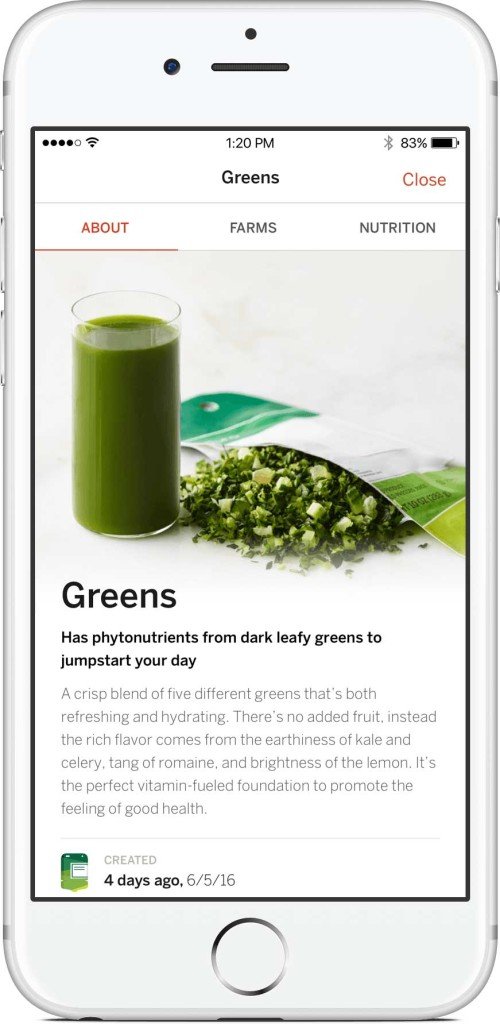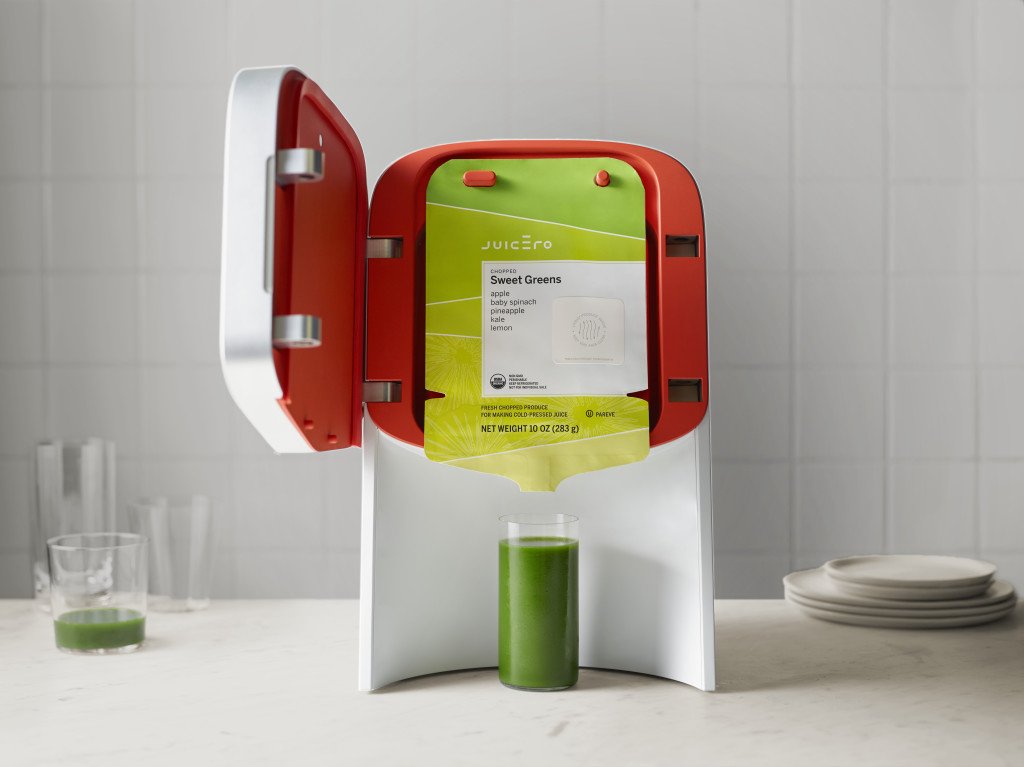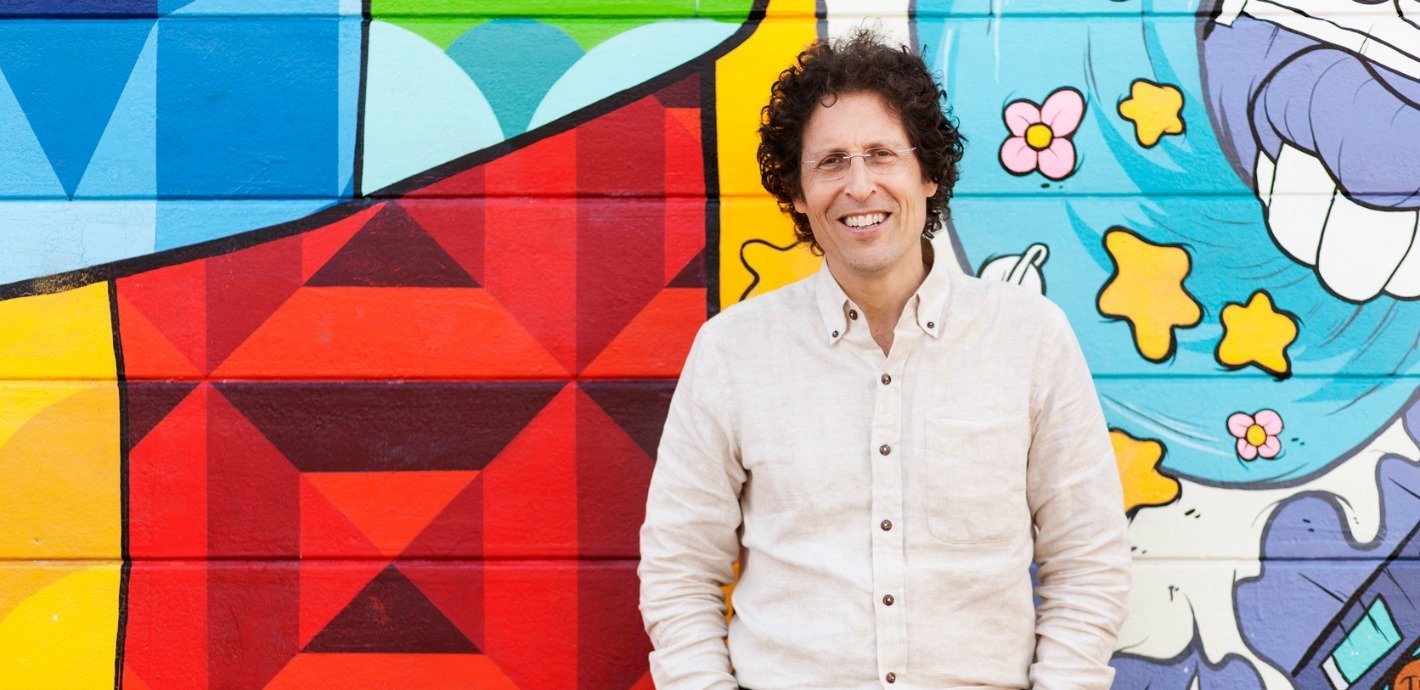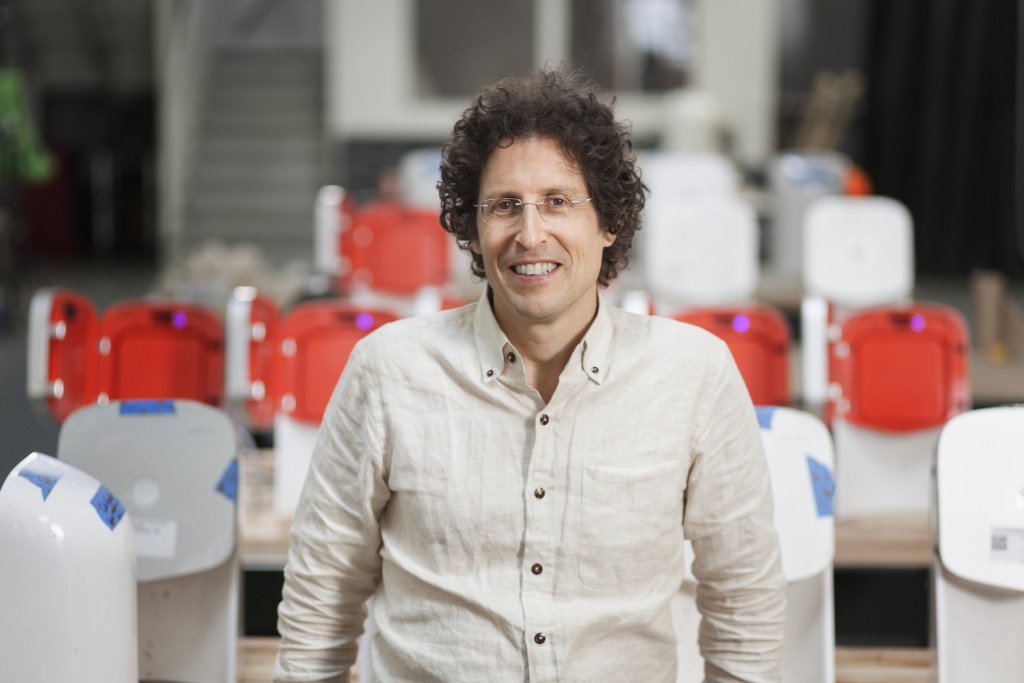One could safely say that Doug Evans has invented the world’s most advanced home juicer. At $699, it’s also the most expensive. For this price tag you get a product that’s Wi-Fi enabled, requires zero clean-up (thanks to the accompanying pouches of fresh fruit and vegetables that have prompted some to call it the “Keurig of juicers”), an app to manage the ordering, delivery, and freshness of said pouches (which cost $4 to $10, and unlike k-cups are recyclable), and a steady stream of cold-pressed organic juice at your fingertips. Juicero launched on March 31 in California.
Such an elaborate piece of machinery could only come to exist at the hands of someone really serious about juicing. Evans, a passionate vegan and yoga practitioner, is the former CEO of New York-based juice brand Organic Avenue. After Evans and his partner Denise Mari, sold a majority of Organic Avenue to an investment firm in 2013, Evans was let go from the company and he found himself at a loss of how to easily make quality cold-pressed juices at home. What started with a combustible prototype in his Brooklyn kitchen evolved into a product backed by $120 million in investments and a mission to reinvent the way people consume fresh fruits and vegetables. Here, we talk to Evans about his journey and what drives him personally and professionally.
You’re very vocal about your passion for juicing and you’ve even built your career around it. What drives this?
What drove me to create this juicer was that I felt I personally needed more servings of fresh, ripe, raw, organic fruits and vegetables, and that it was really hard to get. Home juicing sounds really ideal. You buy the juicer, you buy the produce, and you make your own juice. But the reality is that it’s a really arduous process to make juice at home. You have to buy all these ingredients, you have to wash all these ingredients, and then you have to make juice, and then clean the juicer. The time commitment to do that is a big one and invariable there’s waste associated with not being able to portion out the recipes precisely. You can’t buy half a cucumber or three leaves of romaine and a slice of a lemon, etc. I felt like my home juicing experience always left me dissatisfied.
So where did you go from there?
Having spent 10 years at Organic Avenue I knew a lot about cold-pressed juice. The way that cold pressing works you basically have a two-part process. You take the produce and you dice it and slice it so you’re not juicing but you’re opening up the cellular walls so if you were to take that diced produce and put it in net or cheesecloth and you squeezed it you would be able to extract juice. Those machines exist in commercial and industrial environments, but they didn’t exist for a home juicer. There were no home juice presses. So I thought, “What if I could make a new form of juicer? If I could reinvent juicing?” And so I kind of set out on this quest and it turns out it was really possible but it took a lot of work and a lot of time to do it.
What were the biggest lessons you took from your experience at Organic Avenue?
My biggest lesson there was to keep it simple. Really there are constantly things that all seem very interesting to do, there’s a lot of temptation. But you really have to keep it simple—if you have a vision, it’s important to stay true to it. When my partner and I took on an investor that wasn’t aligned with our core values it didn’t end well. In hindsight, had we stayed more focused, there might have been a different outcome.
Related: How to Change the Climate at Work
When I look at my current team at Juicero, I love them all. The investors are really aligned with the mission. They want to co-create something that will really make a difference. How do you build a business on a mission? Most businesses, if you look at a Fortune 500 publicly traded company, many of them are focused solely on shareholder values. When that’s the goal you can see consequences and choices made that can compromise integrity. Most food products today are unworthy of human consumption. When I started Juicero, I wanted to focus on doing something that would really make a difference, make juice more accessible, delicious, and nutritious.
Can you tell us about the creative evolution of the Juicero product and its many layers of functionality?
It’s all driven around necessity. For example, connecting the juicer to Wi-fi solves a problem of freshness. Most people don’t know when produce is fresh or not, and so you push the limits of consumption. [The Juicero press is a smart device that remains connected to the internet for real-time updates. Sensors in the machine scan the produce pack’s QR code to check its freshness.]
I also wanted people to know where the produce was coming from. I wanted to have a framework in the business where I would not store fresh, perishable produce in a plant. I would get orders [for the packs] online and convert the [juice] recipes into a shopping list with exact tonnage. So the freshest possible produce comes into the plant, where it’s washed, chopped, and mixed, into a pack. [The Juicero app] shows what produce is coming from what farm, when we’re packing it, when it expires, what the ingredients are, and what nutrition information is.
It sounds like through the product design you’re espousing a values system around what we eat.
Do you think of it that way?
The highest order driver is that I believe people need more servings of fruits and vegetables. If you can make it easier for people to have more of these nutritious servings, they would be healthier. If you’re establishing what those servings are, of fruits and vegetables, why not make them organic, fresh, ripe, and local? That was a challenge that I thought was really interesting to explore. Today, the daily recommended amount of fruits and vegetables are over 10 servings per day. The average American has less than 1 and they might consider a serving to be potatoes. So this is something that I really wanted to get into—just raising the standard.
What I’ve experienced in the last 17 years is that people will pretty much eat and drink what’s put in front of them. If you put better stuff in front of them, they’ll consume it, and if you put worse stuff in front of them, they’ll consume it. So I just wanted to do better. That’s what Juicero was about—making it both convenient and nutritious.
Related: Crisp & Clean Green Juice
The Juicero product certainly makes juicing more accessible in terms of time saving and ease of use—but the price point is high, at almost $700. What are your thoughts on this?
When you’re truly creating an innovative breakthrough product it starts off expensive. We’ve done everything we could to lower the cost to make it accessible. But it’s a really industrial piece of equipment in a beautiful, elegant consumer design. When I look at the price point of where people are spending money, there are a lot of things that are not a vote for good health. We look at Juicero as an incredible investment in people’s health. The Vitamix is theoretically expensive [at close to $400]. People would complain about that and procrastinate on buying the Vitamix, but then after they purchased it they are really happy with it. I think the value over time is there and if someone wants to get more fresh produce into their bodies, other than apples, bananas and oranges—and they want to get fresh raw greens and root vegetables and fresh ginger into their bodies I think Juicero makes it the most available and accessible than ever to do that. It’s not for everyone, although everyone would benefit from it, it’s not for everyone to start with. So that’s where our plans to make it available to certain individuals first, but also making it available in offices and restaurants so people can experience it by the glass without having to purchase the hardware.
I read that the initial prototype juicer you created regularly blew apart in your Brooklyn apartment. What motivated you to keep going with this idea?
I’ve never quit anything in my life. I just have grit and my core values are unrelenting. In that instance I just realized I needed to be safer and I just started wearing goggles in the lab because I realized shrapnel was really flying! As long as there is breath in me, so long I will persist.
That sounds like the Ashtanga practitioner in you! Can you tell me about your yoga practice?
I started practicing Ashtanga in 2000 in Maui with Eddie Modestini and Nicki Doane. In New York, I practiced with Guruji [Sri K. Pattabhi Jois] at the Puck Building when he was on the worldwide tour. Then I was kind of on-and-off until 2004 when I was on tour with Michael Franti and Eddie and Nicki and there I got very deep into practicing every day. After that I wanted to go seek their teacher’s teacher so I went to Mysore in 2004 and lived in Gokulam for six months and started at the beginning with Saraswati Jois, Sharath Jois, and Guruji. I started learning Primary Series from the beginning. I continued practicing with Eddie Stern in New York and other teachers in San Francisco and Brooklyn through 2013, and now I have an Ashtanga Mysore self-practice at home. It is a very light practice, I do mostly standing poses and a couple of the seated poses to Marichyasana B and C, then I do the finishing poses, and I’m done.
How does it influence your life?
Right now, it’s bringing tears to my eyes, I don’t know why. I think that what it did for me was to help ground me, with all the chaos that’s going on, it’s one of the rare times I don’t have my phone in my hand and I’m totally present on my breath on my bandhas. It’s a little respite that I treat myself to. My world is pretty stressed with what I’m doing. There’s enormous pressure, and I feel my shoulders rising up to my ears frequently. When I go back into Samasthiti, it brings me back and I start to breathe and I start to move and circulate my blood. I feel if I don’t do my practice, then I get stiff and feel pain and it hurts and it affects my ability to function and perform. It’s really the counterbalance for me for the intensity of the game that I’m playing in, which is really potentially and conceivably overwhelming. I am running a technology company with a dozen PhDs, 45 engineers, and seven food scientists, and I cheated my way through high school!
Can you tell me more about your meditation practice?
After I left Mysore I went to Tamil Nadu and I did my first 10-day Vipassana meditation. Since then I’ve done one other 10-day sit, and I use the mindfulness of Vipassana to be totally present, from observing my breath, to observing my sensations, to being more balanced, and maintaining that state of equanimity. Even when things come up—and stuff always comes up—I’m able to observe them and not react to them or overreact to them and it’s been very effective for me to have a broad perspective.
Do you practice every day?
That would be the goal. I would say I have a regular practice. In my most idealized world, I would sit twice a day for an hour. Sometimes I get as little as 5 or 10 minutes a day the same way sometimes my Ashtanga practice is reduced to Suryanamaskara B.
What was your lifestyle like before you became a vegan and what changed when you adopted this way of life?
Before I was a vegan I was overweight, I had bad posture, I had the propensity to rage, I was selfish, borderlining narcissistic, and just really not very present. I initially became a vegan for health reasons and I found myself wanting to walk on the sunny side of the street. I found myself drawn to more environmental issues. Then the ethical, moral aspect hit me like a ton of bricks. At first I was a dietary vegan, but I would still justify wearing leather shoes or a coat and I didn’t really make the connection early on. Then as my heart opened up, I started to make the connection. And then I became vegan for all reasons.
What does a typical day of eating look like for you?
When I wake up in the morning I will press a Juicero Chopped Greens. I will get to the office a few hours later and then will have a glass of the Sweet Roots juice, and then I’ll eat a pomelo or a ruby red grapefruit for breakfast. Then for lunch I’ll have a fresh coconut and eat the meat and water and have a green juice—our Sweet Green Juice. For dinner I might have a big salad with avocados, nuts, peppers, and tea.
Where are you or what are you doing when you feel you’re most inspired and at ease?
I am most inspired when I’m creating things. Whether it’s writing or drawing or sharing a big idea. Speaking to you in this moment is totally inspiring me. Sharing ideas with people that are receptive with open hearts is when I’m most inspired.
Is there a place you go to in your daily life or a practice aside from yoga that you try and incorporate for overall balance?
I also like to swim on the weekends. I’ll swim a mile on my back—35 laps in the pool. I like to go to the pool when there’s no one there. I’ll be the first person there at 5 a.m. or last one at 9 p.m. I love the feeling of weightlessness and floating in the pool.
In your yoga and meditation practice, or at work, is there a text you find particularly insightful that you find yourself returning to over time?
One book is As a Man Thinketh by James Allen. I also like a couple chapters in The Greatest Salesman in the World by OG Mandino.
Note: Sonima.com’s founder owns a fractional minority share in Juicero.









Comments (0)